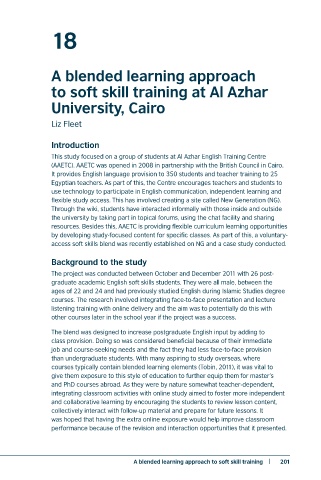Page 204 - BLENDED LEARNING
P. 204
18
A blended learning approach
to soft skill training at Al Azhar
University, Cairo
Liz Fleet
Introduction
This study focused on a group of students at Al Azhar English Training Centre
(AAETC). AAETC was opened in 2008 in partnership with the British Council in Cairo.
It provides English language provision to 350 students and teacher training to 25
Egyptian teachers. As part of this, the Centre encourages teachers and students to
use technology to participate in English communication, independent learning and
flexible study access. This has involved creating a site called New Generation (NG).
Through the wiki, students have interacted informally with those inside and outside
the university by taking part in topical forums, using the chat facility and sharing
resources. Besides this, AAETC is providing flexible curriculum learning opportunities
by developing study-focused content for specific classes. As part of this, a voluntary-
access soft skills blend was recently established on NG and a case study conducted.
Background to the study
The project was conducted between October and December 2011 with 26 post-
graduate academic English soft skills students. They were all male, between the
ages of 22 and 24 and had previously studied English during Islamic Studies degree
courses. The research involved integrating face-to-face presentation and lecture
listening training with online delivery and the aim was to potentially do this with
other courses later in the school year if the project was a success.
The blend was designed to increase postgraduate English input by adding to
class provision. Doing so was considered beneficial because of their immediate
job and course-seeking needs and the fact they had less face-to-face provision
than undergraduate students. With many aspiring to study overseas, where
courses typically contain blended learning elements (Tobin, 2011), it was vital to
give them exposure to this style of education to further equip them for master’s
and PhD courses abroad. As they were by nature somewhat teacher-dependent,
integrating classroom activities with online study aimed to foster more independent
and collaborative learning by encouraging the students to review lesson content,
collectively interact with follow-up material and prepare for future lessons. It
was hoped that having the extra online exposure would help improve classroom
performance because of the revision and interaction opportunities that it presented.
200 | A thinking-based blended learning course A blended learning approach to soft skill training | 201

